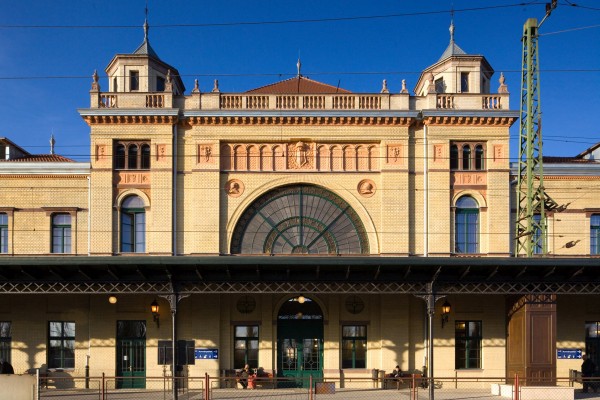From train depot to a public space
Railway Station, Pécs
Architect: Tibor Hajós
Text: Mónika Pilkhoffer
Photos: Tibor Zsitva

It was a milestone for Pécs in 2010 that the city, being an European Culture Capital then, was given the chance to get enriched with several new cultural and infrastructural developments.
An exception was the building of the railway station which had been in need of reconstruction for a long time, and which had thus been an unworthy structure to welcome visitors arriving in the city via rail. Launched in November, 2013 the reconstruction had been finished by the autumn of 2015. A characteristic feature of the facade of the railway station building was the semi-circular motif of the glazed central projection surrounded by spires, which bears resemblance to other railway stations such as the one in Debrecen and Cluj Napoca (Romania). Precious decorative components of the facade are the pyrogranite reliefs produced in the Zsolnay manufactory. The reconstruction project started in 2013 restored a railway station into its original form and beauty which, however, also meets the criteria of the 21st century. The authentic restoration of the original mass of the structure was followed by the replacement of the roof, the cleaning of the clinker facework, the completion of the missing ornaments (tin, ceramics and wrought iron as well), replacing the columns supporting the roof of the platform zone, updating the engineering parts and facelifting the interiors. The latter were given new functions as rail travel means something completely different today than a century ago. In line with prevailing western tendencies, the goal was to transform the station into a genuine community space.
General design: Hajós Építész Iroda Kft.
Leading architect: Tibor Hajós
Architects: Jánosné Apró Juhász, Ágnes Kovács, Sándor Németh, Gábor Módra
Historical research: Nóra Pete
Painting restoration expert: Zsuzsa Herling
Sculptor restoration expert: Attila Kovács
Lamps: László Dvorszky
Interior design: Tibor Hajós
Statics: Péter Rabb, Balázs Szabó, Miklós Molnár
Insulation: András Koza, Iván Záhonyi
Insulation expert: István Dér
HVAC: Szilárd Kisapáti, Tamás Tóth
Electrical engineering: Antal Papp
Light current: Tamás Szalóki
Fire protection: Sándor Kacziba
Public utility: Mihály Tóth
Elevator: Attila Szirovicza
Environment expert: László Sipos
Soil mechanics: Dr. Ferenc Kaszás
Kitchen technology: Katalin Kelemenné Takács







